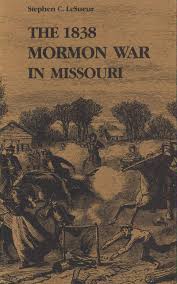Articles/Essays – Volume 22, No. 3
A Double Dose of Revisionism | Stephen C. LeSueur, The 1838 Mormon War in Missouri
Each year first-class presses add to the growing number of excellent Mormon monographs. Twenty-nine major studies appeared in 1988 alone. These two volumes from the University of Missouri Press and the University of Oklahoma Press are worthy companions to the best of recent years.
LeSueur’s revisionist study challenges many traditional ideas about the persecutions of the Saints in Missouri during the 1830s. He argues the Saints’ own militancy, Zionist aspirations, prejudice, and poor judgment led to the “Mormon War” of the summer and fall of 1838 and the sub sequent expulsion of the Mormons from Missouri into Illinois.
The author has not only used recently discovered sources, including journals, letters, petitions, and official documents but has elected to present a much-needed, de tailed description of the Missourians’ attitudes and activities. Many readers will disagree with LeSueur’s sometimes negative and sharp criticism of Church leaders during this Missouri period, but these new interpretations deserve study and consideration. Although he refutes many LDS claims, he does so objectively, giving the verse and chapter of his evidence. (For a very recent and more traditional interpretation of the Missouri persecutions see Firmage and Mangrum, Zion in the Courts . . . , [Urbana and Chicago: University of Illinois Press, 1988], pp. 59-79; and Jesse and Whittaker, “The Last Months of Mormonism in Missouri . . . ,” BYU Studies 28 [Winter 1988]: 5-41.)
LeSueur’s definitive study of one of the most difficult and important periods in early Mormon history fills a major lacuna. His book is thoroughly researched and massively documented with 664 footnotes. (He did, however, miss some important documents in the Missouri Historical Society in St. Louis.) The book includes fifteen illustrations, two maps, and a bibliographic essay.
Although the Saints had been in Missouri since 1831, three developments in the spring and summer of 1838 led to their final denouement. First they began to gather in Missouri in greater numbers; second, a number of their members banded together in a secret, militant (Danite) society; and, finally, they adopted a belligerent stance against their perceived enemies outside the Church.
The role of the Danites is one of LeSueur’s main topics, his black beast. He argues persuasively that despite belief and tradition, Joseph Smith and other Church leaders not only knew of the Danites, but approved of their organization and activities. Indeed, LeSueur goes so far as to write, “The Danites represented main stream Mormonism” (p. 46). Here LeSueur and I part company; I feel this view is an exaggeration.
Perhaps the author’s most startling revisionism is Chapter 7, “The Mormons Retaliate,” in which LeSueur’s Mormons “loot,” “confiscate,” “set fire,” “plunder,” “threaten,” commit “desperate crimes,” and “gut Daviess County”—activities seldom mentioned in official Church histories and manuals.
Bennett’s book is also a definitive, massively documented (978 notes) treatment of an important but little known and under stood period in Mormon history—Winter Quarters. (It is much superior to the recent account of the same subject by Conrey Bryson.) The author’s thesis is that much of what became peculiarly Mormon evolved at Winter Quarters. He terms it “Mormonism in the raw on the way to what it would be later in the century” (p. 169).
Most readers view the Winter Quarters period as a hiatus between the Nauvoo and the Salt Lake Valley experiences, a mere way station to be endured, a period when little of real import happened. Bennett carefully and compellingly shows the error of this assumption. He maintains that important economic, political, and theological developments crowded upon each other during this period: the Saints learned how better to deal with the U.S. government and the Indians; apostolic supremacy and succession were made firm; revelations were received, new patterns of worship implemerited, and a battalion raised; and of course, plans for the great trek west were formulated.
Readers will find some surprises in Bennett’s account of just what Joseph Smith said and did not say about the Saints going west and just how much, or how little, Brigham Young knew about where the Church was to resettle there; furthermore, tables clarify some of the vexing demo graphic questions about the Winter Quarters era.
The first four of Bennett’s fifteen chapters track the Saints to Winter Quarters and see them settled. The remaining chapters systematically and thoroughly treat different aspects of the Winter Quarters experience—Indians and Indian agents, eco nomics, sickness and death, Mormon society on the frontier, social and religious life, re-establishment of the First Presidency, and the abandonment of Winter Quarters.
I wish the author had made more of the trek across Iowa and of the main 1848 departure from Winter Quarters, but these are hardly serious reservations. I thoroughly recommend both these monographs to all serious students of the Mormon scene, the exodus, American frontier communities, and Missouri trials.
The 1838 Mormon War in Missouri by Stephen C. LeSueur (Columbia: University of Missouri Press, 1987), 286 pp., $24.00, and Mormons at the Missouri, 1846-1852: “And Should We Die . . .” by Richard E. Bennett (Norman: University of Oklahoma Press, 1987), 347 pp., $24.95.


 Back to full Issue
Back to full Issue

